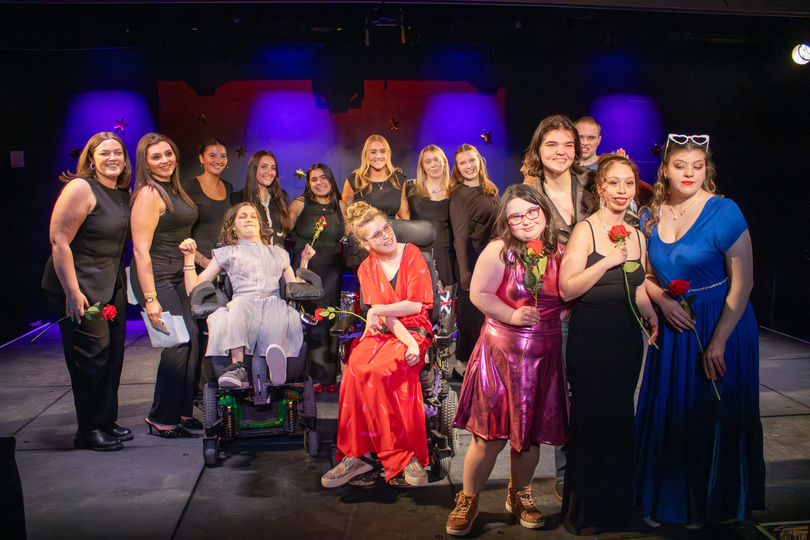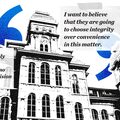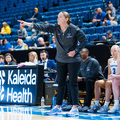‘Runway of Dreams’ adaptive fashion show slides inclusivity into the spotlight

The Runway of Dreams Foundation, who aims to create an inclusive environments in the fashion industry, hosted a fashion show at Syracuse University. The show featured eight models with disabilities in stunning outfits as well as had performances from SU acapella groups The Otto Tunes and The Mandarins. Leonardo Eriman | Asst. Video Editor
Get the latest Syracuse news delivered right to your inbox.
Subscribe to our newsletter here.
Nicole Massab confidently strutted down the runway under purple and pink lights as Metallica’s “Enter Sandman” played in the background. She sported a blue dress with a rhinestone belt and shoes to match. When she posed, the audience erupted with applause, but the attention didn’t throw her off.
“I was born for this,” Massab said. “Ever since I was a little kid, I was made for the stage.”
The Syracuse University chapter of Runway of Dreams hosted its first Adaptive Fashion Show on Sunday night at SU’s Schine Student Center Underground, featuring eight models with disabilities alongside performances from a capella groups Otto Tunes and The Mandarins. The show emphasized adaptable clothing features that make trendy, affordable clothing more accessible.
The show encompassed multiple aspects of accessibility, including an American Sign Language interpreter, live captions displayed on a screen and wheelchair-accessible ramps. The clothing on the runway featured Velcro buttons, adaptable zippers or longer hemlines to ensure coverage for people who use wheelchairs. Senior Elena Fliszary, president of Runway of Dreams, said these small details are what it takes to make clothing fully accessible.
Vice President Sonali Suri said getting the word out about Runway of Dreams was hard as a new group on campus. The club struggled with engagement and recruiting models. Sophomore Mary Kate Bolster, model management chair for the club, said the team collaborated with other organizations that support students with disabilities and the national branch of Runway of Dreams to help get off the ground.
The hard work paid off in rewarding experiences for both the organizers and their families, Bolster said. Throughout the preparation process for the show, parents thanked her for creating the space for their children to be included.
An opportunity to be in the spotlight was important for model Sasha Soraci, who sported a Skims dress, heels and dazzling jewelry. Soraci said she was bullied growing up, but her love of music, fashion and makeup guided her through the difficult parts of her childhood.
Soraci said her mom was her biggest inspiration as she taught her to present herself every day as if she was on stage. After walking the runway, Soraci said that though she’s still young, she knows she wants her kids to have the same chance to be in the spotlight one day. She said the community she’s found at SU has given her confidence.
“I had so much drama, but I always put my right foot forward, then the left one, then go strut all throughout Syracuse,” Soraci said.

Runway of Dreams Model Ruby Katan embraces E-Board Member Carly Klonsky before the show. Ruby was the first model of night as she wore a shiny pink dress down the runway.
Leonardo Eriman | Asst. Video Editor
Bolster said a pillar of the club’s mission is addressing deficits in inclusivity. After her experience planning the show, she said she would always carry the importance of inclusivity with her, because everyone deserves to have a moment like the eight models did Sunday night.
“Being part of it has shown me how much it means for these students to feel included. Giving them a spot to feel assimilated on campus makes them so happy,” Bolster said.
Bolster’s favorite part of working with Runway of Dreams is building relationships with models who are disabled. At Sunday’s show, she pushed model Marley Aberdeen’s wheelchair down the runway, letting Aberdeen’s mom enjoy her daughter’s moment in the spotlight.
Suri said one of the biggest challenges of the show was finding adaptive clothing that’s also on-trend with what college students want to wear. Adaptive clothing is often too mature for a young adult, Bolster said, and too expensive for many budgets.
Suri said the show’s purpose was to encourage more brands to popularize adaptive clothing.
She thinks it’s important for everyone to express themselves through clothes, especially on a college campus, and the show gave models with disabilities that opportunity.
“Watching them light up as they wore their shoes or their outfits really made me happy,” Suri said. “These people are stars.”
Massab said she would keep the experience of walking the runway with her forever, and that it inspired her to never stop pursuing her dreams. She said that because everything about the show was inclusive, it allowed her to feel the love from the SU community.
“We don’t want you guys to treat us any differently,” Massab said. “We are only human, and we want to be our own person with our own personality.”






